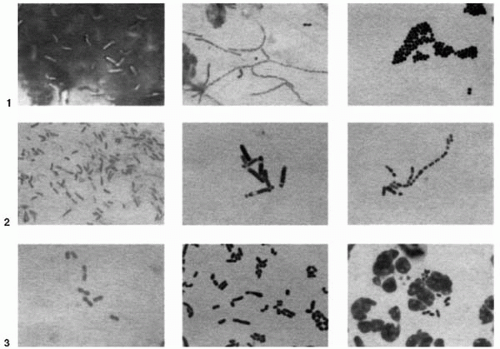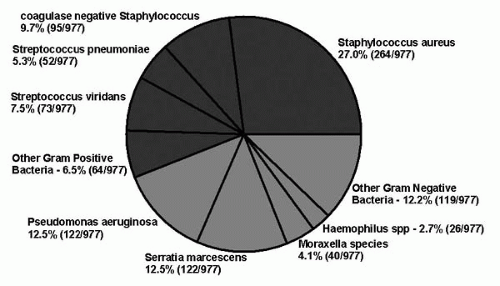bacteria (aerobes) require oxygen for growth, whereas oxygen is toxic to other bacteria. These bacteria are classified as anaerobes. Many bacteria are facultative anaerobes in that growth occurs under either aerobic or anaerobic conditions. Bacteria also grow better at certain temperature and atmospheric conditions. In general, bacteria are incubated for isolation at body temperature (37°C or 98.6°F) and under a 6% CO2 atmospheric condition. Mycobacteria require different incubating temperatures, different light conditions, and extended incubation periods for isolation and identification.
 FIGURE 12-1. Microphotographs of gram-positive (blue) and gram-negative (red) bacteria that infect the cornea. (Original magnification × 100, oil immersion; photographed by Lisa M. Karenchak.) Row 1, left: diplococci (Streptococcus pneumoniae); row 1, middle: pleomorphic rods (diphtheroids); row 1, right: diplobacilli (Moraxella). Row 2, left: chain of cocci (Streptococcus); row 2, middle: rods with endospores (Bacillus); row 2, right: rods (Pseudomonas aeruginosa). Row 3, left: grapelike clusters of cocci (Staphylococcus aureus); row 3, middle: thin filaments (Actinomyces); row 3, right: nonstaining ghost rods (Mycobacterium chelonae). (See color figure.) |
of antibacterial susceptibility for bacterial keratitis isolates because therapy is topical instead of systemic. NCCLS susceptibility interpretations can be used for ocular isolates if the assumption is made that the antibiotic concentration in the ocular tissue is at least as great as the antibiotic concentrations achieved in the blood serum.
TABLE 12-1. SUSCEPTIBILITY OF GRAM-POSITIVE BACTERIAL ISOLATES FROM KERATITIS TO COMMON ANTIBIOTICS (PERCENTAGE SUSCEPTIBLE, 1993-2002) | |||||||||||||||||||||||||||||||||||||||||||||||||||||||||||||||||||||||||||||||||||||||||||||||||||||||||||||||||||||||||||||||||||||||||||||||||||||||||||||||||
|---|---|---|---|---|---|---|---|---|---|---|---|---|---|---|---|---|---|---|---|---|---|---|---|---|---|---|---|---|---|---|---|---|---|---|---|---|---|---|---|---|---|---|---|---|---|---|---|---|---|---|---|---|---|---|---|---|---|---|---|---|---|---|---|---|---|---|---|---|---|---|---|---|---|---|---|---|---|---|---|---|---|---|---|---|---|---|---|---|---|---|---|---|---|---|---|---|---|---|---|---|---|---|---|---|---|---|---|---|---|---|---|---|---|---|---|---|---|---|---|---|---|---|---|---|---|---|---|---|---|---|---|---|---|---|---|---|---|---|---|---|---|---|---|---|---|---|---|---|---|---|---|---|---|---|---|---|---|---|---|---|---|
| |||||||||||||||||||||||||||||||||||||||||||||||||||||||||||||||||||||||||||||||||||||||||||||||||||||||||||||||||||||||||||||||||||||||||||||||||||||||||||||||||
TABLE 12-2. SUSCEPTIBILITY OF GRAM-NEGATIVE BACTERIAL ISOLATES FROM KERATITIS TO COMMON ANTIBIOTICS (PERCENTAGE SUSCEPTIBLE; 1993-2002) | ||||||||||||||||||||||||||||||||||||||||||||||||||||||||||||||||||||||||||||||||||||||||||||||||||||||||||||||||||||||||||||||||||||||||||||||||||||||||||||||||||||||||||||||||||||||||||||||||||||||||||||||||||||||||||||||||||||||||||||||||||||||||||||||||||||||||||||||||||||||||||||||||||||||||||||||||||||||||||||||||||||||||||||||||||||||||||||||||||||||||||||||||||||||||||||||||||||||
|---|---|---|---|---|---|---|---|---|---|---|---|---|---|---|---|---|---|---|---|---|---|---|---|---|---|---|---|---|---|---|---|---|---|---|---|---|---|---|---|---|---|---|---|---|---|---|---|---|---|---|---|---|---|---|---|---|---|---|---|---|---|---|---|---|---|---|---|---|---|---|---|---|---|---|---|---|---|---|---|---|---|---|---|---|---|---|---|---|---|---|---|---|---|---|---|---|---|---|---|---|---|---|---|---|---|---|---|---|---|---|---|---|---|---|---|---|---|---|---|---|---|---|---|---|---|---|---|---|---|---|---|---|---|---|---|---|---|---|---|---|---|---|---|---|---|---|---|---|---|---|---|---|---|---|---|---|---|---|---|---|---|---|---|---|---|---|---|---|---|---|---|---|---|---|---|---|---|---|---|---|---|---|---|---|---|---|---|---|---|---|---|---|---|---|---|---|---|---|---|---|---|---|---|---|---|---|---|---|---|---|---|---|---|---|---|---|---|---|---|---|---|---|---|---|---|---|---|---|---|---|---|---|---|---|---|---|---|---|---|---|---|---|---|---|---|---|---|---|---|---|---|---|---|---|---|---|---|---|---|---|---|---|---|---|---|---|---|---|---|---|---|---|---|---|---|---|---|---|---|---|---|---|---|---|---|---|---|---|---|---|---|---|---|---|---|---|---|---|---|---|---|---|---|---|---|---|---|---|---|---|---|---|---|---|---|---|---|---|---|---|---|---|---|---|---|---|---|---|---|---|---|---|---|---|---|---|---|---|---|---|---|---|---|---|---|---|---|---|---|---|---|---|---|---|---|---|---|---|---|---|---|---|---|---|---|---|---|---|---|---|---|---|---|---|---|---|---|---|---|---|---|---|---|---|---|---|---|---|---|---|
| ||||||||||||||||||||||||||||||||||||||||||||||||||||||||||||||||||||||||||||||||||||||||||||||||||||||||||||||||||||||||||||||||||||||||||||||||||||||||||||||||||||||||||||||||||||||||||||||||||||||||||||||||||||||||||||||||||||||||||||||||||||||||||||||||||||||||||||||||||||||||||||||||||||||||||||||||||||||||||||||||||||||||||||||||||||||||||||||||||||||||||||||||||||||||||||||||||||||
Stay updated, free articles. Join our Telegram channel

Full access? Get Clinical Tree



